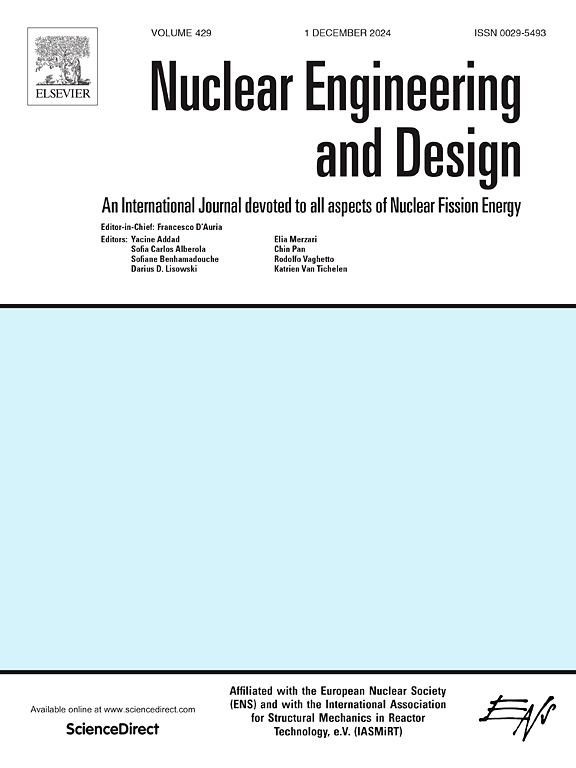泵的空化性能预测方法第四部分——轴流式反应堆冷却剂泵的灵敏度和精度验证
IF 1.9
3区 工程技术
Q1 NUCLEAR SCIENCE & TECHNOLOGY
引用次数: 0
摘要
为了解决轴流式反应堆冷却剂泵(rcp)空化性能预测的挑战,在题为“泵空化性能预测方法PART3适用于轴流式反应堆冷却剂泵”的研究中提出了一种新的方法。通过对轴流泵的实验研究,验证了该方法的可行性。在此基础上,本研究提出了一种基于压力等表面积比的单相空化性能预测方法。通过数值模拟和实验验证相结合,研究了不同流动条件下压力等值面与临界净正吸力水头(NPSH)的关系。开发了一个模型来表示压力等表面积与叶片面积的比率,从而深入了解空化的发生和发展机制。研究结果强调了该面积比对流量变化的敏感性。在验证过程中,对不同面积比(Rs = 9.67%、Rs = 10.52%和Rs = 11.76%)的预测结果进行了比较。结果表明,当Rs = 10.52%时,空化性能预测与实验结果吻合较好,精度较高。该方法大大减少了泵设计过程中所需的迭代优化步骤,从而提高了设计效率。此外,通过对不同流量条件下压力等表面积变化趋势的详细分析,进一步验证了该方法在多种工况下的可靠性和适用性。本文章由计算机程序翻译,如有差异,请以英文原文为准。
A cavitation performance prediction method for pumps PART4—Sensitivity and accuracy validation for axial-flow reactor coolant pump
To address the challenges of predicting cavitation performance in axial-flow reactor coolant pumps (RCPs), a new method was proposed in the study titled “A Cavitation Performance Prediction Method for Pumps PART3 Feasible for Axial-Flow Reactor Coolant Pump” [1]. The feasibility of this method was validated through experimental studies on axial pumps. Building upon this work, the current research proposes a single-phase cavitation performance prediction method based on the pressure isosurface area ratio. By integrating numerical simulations and experimental validation, the study explores how the pressure isosurface correlates with the critical net positive suction head (NPSH) across different flow conditions. A model was developed to represent the ratio of the pressure isosurface area to the blade area, offering insights into the mechanisms of cavitation onset and progression. The findings emphasize the sensitivity of this area ratio to variations in flow rate. During validation, predictions for different area ratios (Rs = 9.67 %, Rs = 10.52 % and Rs = 11.76 %) and compared with experimental data. The results demonstrate that when Rs = 10.52 %, the cavitation performance prediction aligns closely with the experimental results, exhibiting high accuracy. This method significantly reduces the iterative optimization steps required during the pump design process, thereby improving design efficiency. Additionally, a detailed analysis of the trends in pressure isosurface area variation under different flow conditions further validates the reliability and applicability of this method across multiple operating conditions.
求助全文
通过发布文献求助,成功后即可免费获取论文全文。
去求助
来源期刊

Nuclear Engineering and Design
工程技术-核科学技术
CiteScore
3.40
自引率
11.80%
发文量
377
审稿时长
5 months
期刊介绍:
Nuclear Engineering and Design covers the wide range of disciplines involved in the engineering, design, safety and construction of nuclear fission reactors. The Editors welcome papers both on applied and innovative aspects and developments in nuclear science and technology.
Fundamentals of Reactor Design include:
• Thermal-Hydraulics and Core Physics
• Safety Analysis, Risk Assessment (PSA)
• Structural and Mechanical Engineering
• Materials Science
• Fuel Behavior and Design
• Structural Plant Design
• Engineering of Reactor Components
• Experiments
Aspects beyond fundamentals of Reactor Design covered:
• Accident Mitigation Measures
• Reactor Control Systems
• Licensing Issues
• Safeguard Engineering
• Economy of Plants
• Reprocessing / Waste Disposal
• Applications of Nuclear Energy
• Maintenance
• Decommissioning
Papers on new reactor ideas and developments (Generation IV reactors) such as inherently safe modular HTRs, High Performance LWRs/HWRs and LMFBs/GFR will be considered; Actinide Burners, Accelerator Driven Systems, Energy Amplifiers and other special designs of power and research reactors and their applications are also encouraged.
 求助内容:
求助内容: 应助结果提醒方式:
应助结果提醒方式:


